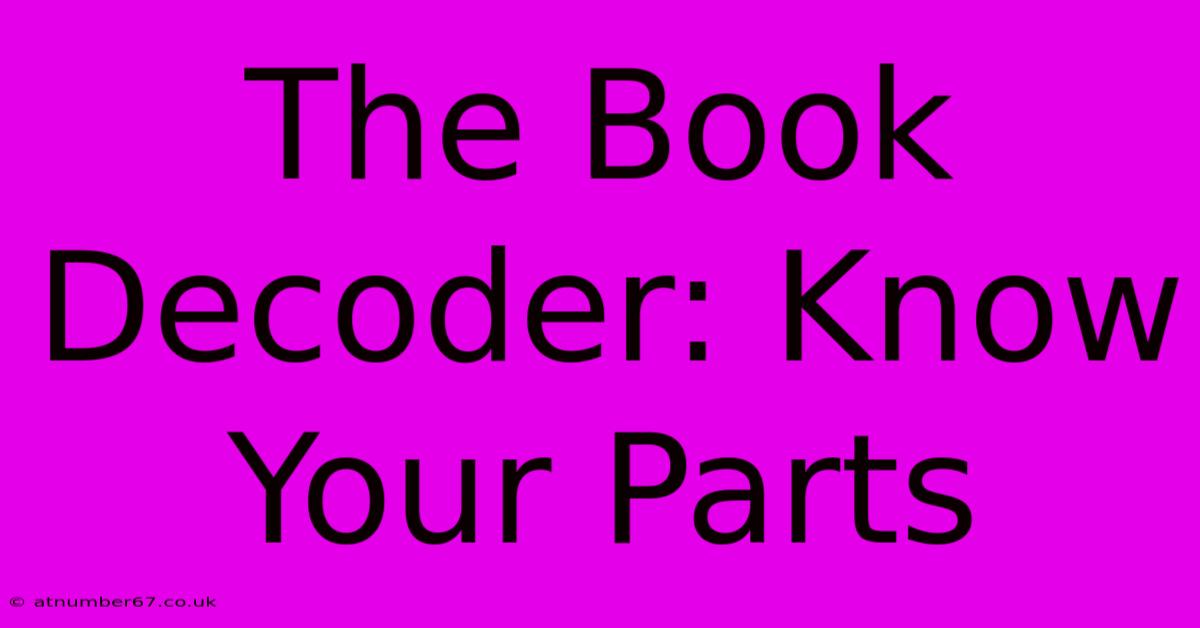The Book Decoder: Know Your Parts

Table of Contents
The Book Decoder: Know Your Parts
So you want to write a book? Fantastic! But before you dive into the thrilling world of plot twists and character development, you need to understand the fundamental building blocks of your manuscript. This article will act as your comprehensive guide to the essential parts of a book, helping you decode the structure and craft a compelling narrative. We'll cover everything from the foundational elements to the finishing touches, ensuring your book is well-organized and ready to captivate readers.
I. The Foundation: Pre-Writing & Planning
Before even a single word hits the page, strong planning is crucial. This stage involves several key components:
1. Idea Generation & Concept Development:
This is where the magic starts! Brainstorming, freewriting, mind-mapping – whatever sparks your creativity. Flesh out your core idea, exploring themes, potential conflicts, and the overall message you want to convey. Strong concepts are the backbone of successful books.
2. Character Development:
Develop compelling characters with believable motivations, flaws, and strengths. Give them backstories, relationships, and arcs that drive the plot forward. Well-developed characters are key to reader engagement.
3. Plot Outline:
This doesn't need to be rigid, but a roadmap helps guide your writing. Outline key plot points, turning points, climax, and resolution. A well-structured plot keeps readers hooked.
4. Worldbuilding (if applicable):
For genres like fantasy and science fiction, constructing a believable and immersive world is vital. Consider geography, culture, history, magic systems, and societal structures. Detailed worldbuilding adds depth and richness.
II. The Structure: Building Your Narrative
Now comes the actual writing! The structure of your book is crucial for a smooth and engaging reading experience.
1. Beginning (Exposition):
Introduce your characters, setting, and the central conflict. Hook the reader from the start! A compelling beginning sets the tone for the whole book.
2. Rising Action:
This section builds tension and suspense as the plot unfolds. Introduce obstacles, complications, and escalating conflicts. Strong rising action keeps the reader invested.
3. Climax:
The peak of tension and conflict where the protagonist confronts the central problem. This is often the most dramatic and impactful part of your story. A powerful climax is memorable.
4. Falling Action:
The aftermath of the climax. The loose ends begin to tie up, and the consequences of the protagonist's actions become apparent. Effective falling action provides resolution.
5. Resolution (Conclusion):
The story concludes, offering closure and a sense of completion. This doesn't always mean a happy ending, but it should feel satisfying and meaningful. A satisfying resolution leaves a lasting impression.
III. The Finishing Touches: Polishing Your Manuscript
Once the core story is complete, meticulous editing and revision are crucial.
1. Self-Editing:
Read your manuscript critically, looking for plot holes, inconsistencies, awkward phrasing, and grammatical errors. Thorough self-editing is a crucial step.
2. Beta Readers:
Get feedback from trusted readers who can provide fresh perspectives on your work. Their feedback can highlight areas for improvement. Beta reader feedback is invaluable.
3. Professional Editing:
Consider hiring a professional editor to polish your manuscript to a publishable standard. Professional editing elevates your writing.
4. Proofreading:
Ensure your manuscript is free of typos and grammatical errors before submitting it. Careful proofreading ensures quality.
Conclusion: Mastering the Book Decoder
Understanding the various parts of a book – from pre-writing planning to the final polish – is vital for crafting a compelling narrative. By meticulously attending to each stage, you can unlock your storytelling potential and create a book that readers will love. Remember, practice and persistence are key! So, start decoding, and let your literary adventure begin!

Thank you for visiting our website wich cover about The Book Decoder: Know Your Parts. We hope the information provided has been useful to you. Feel free to contact us if you have any questions or need further assistance. See you next time and dont miss to bookmark.
Featured Posts
-
Ibrahim Ali Khan Age A Sneak Peek
Apr 05, 2025
-
The Truth About Mark Cubans Net Worth
Apr 05, 2025
-
Daniel Ricciardos Net Worth The Power Of Branding
Apr 05, 2025
-
Rosie O Donnells Net Worth Beyond The Celebrity Spotlight
Apr 05, 2025
-
Erzurum Community Rallies After Recent Death
Apr 05, 2025
